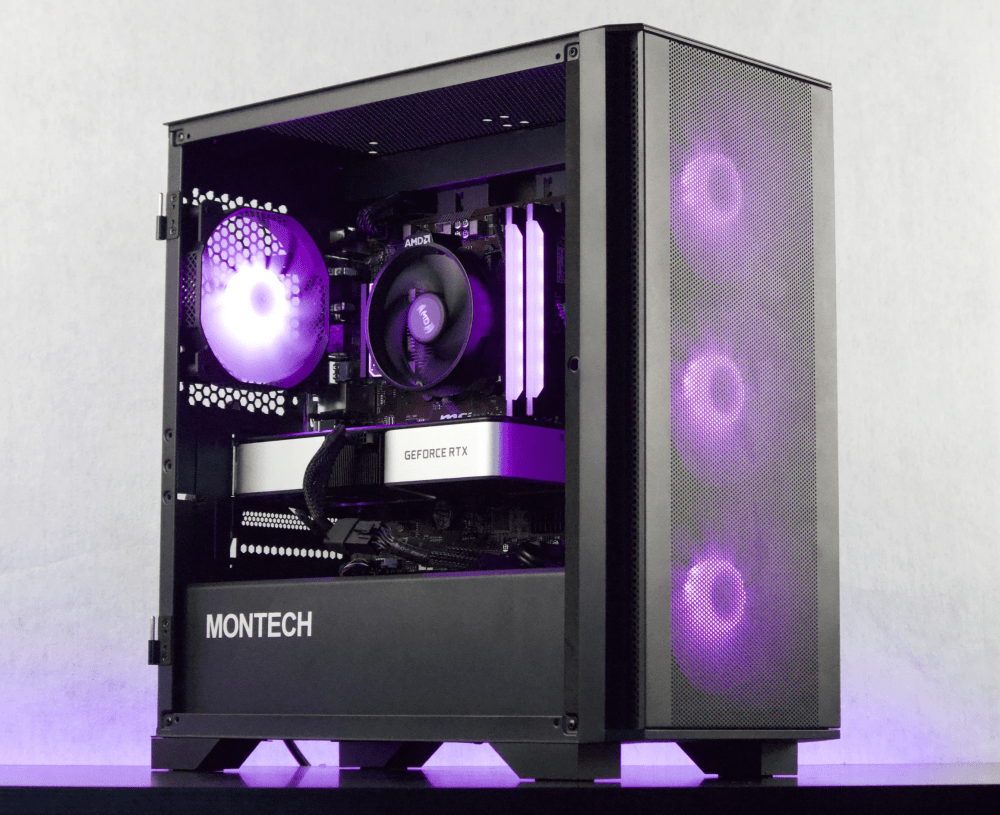Looking to upgrade your CPU? Check out Jawa for killer deals on new and used processors.
Undervolting your CPU can be a game-changer when it comes to optimizing its performance and improving efficiency. By reducing the voltage supplied to your processor, you can potentially lower power consumption, reduce heat output, and even extend the lifespan of your CPU. In this blog post, we will guide you through the process of undervolting your CPU step by step, ensuring that you have a smooth and successful experience.
Before we dive into the details, let's first understand the basics of undervolting and why it can be beneficial. Undervolting involves lowering the voltage supplied to your CPU while maintaining stable performance. This can result in several advantages, such as reducing power consumption and heat generation, which can lead to lower energy bills and quieter operation. Additionally, undervolting can help to decrease the risk of thermal throttling and prolong the lifespan of your CPU.
To prepare for the undervolting process, it is essential to understand your CPU specifications. Each CPU model has its own optimal voltage range, and knowing this information will help you determine the ideal voltage settings for your chip. Furthermore, you will need to gather the necessary software tools, such as undervolting software specific to your CPU model. These tools will provide you with the ability to adjust the voltage settings and monitor the performance of your CPU.
Undervolting your CPU requires taking precautionary measures to ensure a safe and successful process. This includes creating a backup of your system and important files, as well as understanding the potential risks involved. While undervolting is generally safe, it is crucial to proceed with caution and follow the instructions carefully.
Now, let's dive into the step-by-step process of undervolting your CPU. We will guide you through opening the undervolting software, adjusting the voltage settings, and properly testing the new CPU settings to ensure stability and optimal performance. Following these instructions will help you achieve the desired results without compromising the functionality of your system.
Once you have successfully undervolted your CPU, it is important to monitor its performance regularly. Inspecting for any performance issues, monitoring CPU temperature, and verifying the stability of your system are crucial steps to ensure that everything is running smoothly. We will provide you with tips and techniques to effectively monitor and maintain your undervolted CPU.
Lastly, we will address common problems that may arise during the undervolting process and provide troubleshooting solutions. Dealing with system instability, addressing overheating issues, and reverting changes if necessary are all important considerations when undervolting your CPU. We will guide you through these challenges, ensuring that you have the knowledge and tools to overcome any obstacles that may come your way.
Undervolting your CPU can be a powerful tool to optimize performance, reduce power consumption, and enhance the overall efficiency of your system. By following the steps and guidelines outlined in this blog post, you will be well-equipped to undervolt your CPU safely and effectively. So, let's get started on this exciting journey towards unlocking the full potential of your CPU!
Understanding the Basics: What is Undervolting and Why it's Beneficial
Undervolting is the process of reducing the electrical voltage supplied to your CPU while maintaining stable performance. This technique allows you to optimize your CPU's power consumption, heat generation, and overall efficiency. By lowering the voltage, you can potentially achieve several benefits:
-
Reduced Power Consumption: Undervolting your CPU can significantly decrease the amount of power it requires to operate. This can result in lower energy bills, making it an attractive option for those seeking to save on electricity costs.
-
Lower Heat Output: One of the primary advantages of undervolting is the reduction in heat generated by your CPU. When the voltage supply is higher than necessary, excess heat is produced, which can impact the overall temperature of your system. By undervolting, you can lower the heat output, leading to more efficient cooling and potentially extending the lifespan of your CPU.
-
Enhanced System Stability: Overclocking, which involves increasing the voltage and clock speed of your CPU, can sometimes lead to instability and crashes. Undervolting, on the other hand, can help stabilize your system by reducing the voltage to a level that is still sufficient for optimal performance but not excessive.
-
Extended CPU Lifespan: Excessive heat generated by your CPU can contribute to its degradation over time. By undervolting and subsequently reducing heat output, you can potentially extend the lifespan of your CPU, ensuring it remains functional for longer periods.
-
Quieter Operation: Undervolting can result in quieter system operation, as reduced heat production often leads to less fan activity. If you prefer a quieter computing experience, undervolting can help achieve this by minimizing the need for the fans to run at high speeds.
-
Environmental Benefits: With reduced power consumption, undervolting contributes to energy conservation and promotes a greener approach to computing. By minimizing the power requirements of your CPU, you are effectively reducing your carbon footprint and helping to conserve valuable resources.
Undervolting is not without its considerations and potential risks. While undervolting can be a safe process, it is important to follow proper procedures and precautions to avoid damaging your CPU or causing system instability. Understanding the basics of undervolting and its benefits is essential before proceeding with the actual undervolting process.
In the following sections, we will guide you through the necessary steps to undervolt your CPU effectively. We will cover the preparation required, the actual undervolting process, monitoring the performance after undervolting, and troubleshooting common problems that may arise. By the end of this blog post, you will have the knowledge and confidence to undervolt your CPU and enjoy the benefits it offers.
Preparation for Undervolting Your CPU
Undertaking the process of undervolting your CPU requires thorough preparation to ensure a smooth and successful experience. In this section, we will discuss the essential steps to prepare for undervolting your CPU effectively.
Understanding Your CPU Specifications
Before you begin undervolting, it is crucial to familiarize yourself with the specifications of your CPU. Each CPU model has its own optimal voltage range, and deviating too far from these specifications can lead to instability or even damage. To obtain the necessary information, you can refer to the manufacturer's website or documentation, or use software tools that provide detailed information about your CPU, such as CPU-Z or HWiNFO.
Pay close attention to the recommended voltage range, as well as any specific guidelines or limitations provided by the manufacturer. This information will serve as a reference point when adjusting the voltage settings during the undervolting process.
Gathering Necessary Software Tools
To undervolt your CPU, you will need specific software tools that are designed for your CPU model. These tools provide the interface and functionality required to adjust voltage settings and monitor the performance of your CPU. Research and identify the appropriate undervolting software for your CPU, ensuring compatibility and reliability.
Popular undervolting software options include Intel XTU (Extreme Tuning Utility) for Intel CPUs and Ryzen Master for AMD CPUs. These tools offer intuitive interfaces and robust features to facilitate the undervolting process effectively. Download and install the software, following the instructions provided by the respective manufacturers.
Taking Precautionary Measures
Undervolting your CPU involves making changes to critical components of your system, so it is essential to take precautionary measures to avoid any potential risks. Here are some key steps to consider:
-
Create a System Backup: Before proceeding with any changes, it is recommended to create a backup of your system and important files. This ensures that you have a restore point in case anything goes wrong during the undervolting process.
-
Update System Drivers and Firmware: Ensure that all your system drivers and firmware are up to date. This helps to ensure compatibility and stability when making changes to your CPU settings.
-
Read the Documentation: Carefully read the documentation provided by the manufacturer for your CPU and undervolting software. Familiarize yourself with any specific instructions, warnings, or limitations mentioned.
-
Take Note of Current Settings: Before making any adjustments, take note of your CPU's current voltage settings. This will allow you to revert to the original settings if needed.
By following these preparation steps, you will be well-equipped to proceed with undervolting your CPU safely and effectively. In the next section, we will delve into the step-by-step process of undervolting your CPU, providing detailed instructions to guide you through each stage.
How to Undervolt Your CPU
Undervolting your CPU involves adjusting the voltage settings to find the optimal balance between performance and power consumption. In this section, we will guide you through the step-by-step process of undervolting your CPU effectively.
Opening the Undervolting Software
-
Launch the undervolting software that you downloaded and installed in the previous section. Ensure that you have administrative privileges, as some software tools require elevated access to make changes to system settings.
-
Familiarize yourself with the user interface of the undervolting software. Different software tools may have varying layouts and options, but the general principles remain the same.
Adjusting the Voltage
-
Start by identifying the voltage settings in the undervolting software. Look for options related to CPU voltage, core voltage, or similar terms. Note that the specific terminology may vary depending on your CPU model and the software tool you are using.
-
Begin by lowering the voltage incrementally. It is recommended to decrease the voltage in small increments, such as 0.010V or 0.025V, and test the stability after each adjustment. This gradual approach helps to find the optimal undervolt without risking system instability.
-
Apply the voltage changes and save the settings in the undervolting software. Depending on the software, you may need to click on a "Apply" or "Save" button to make the changes take effect.
Properly Testing the New CPU Settings
-
After adjusting the voltage settings, it is crucial to test the stability of your CPU under the new undervolted configuration. Stability testing helps ensure that the system can handle the reduced voltage without crashing or experiencing errors.
-
There are several stress testing software options available, such as Prime95 or AIDA64. These tools put your CPU under heavy load to simulate real-world usage scenarios. Run the stress test for a reasonable duration (e.g., 30 minutes to an hour) to evaluate the stability of your CPU.
-
Monitor the system during the stress test, paying close attention to the CPU temperature and any signs of instability, such as system crashes, blue screens, or application errors. If any issues occur, you may need to adjust the voltage settings again to find a stable configuration.
-
Repeat the process of adjusting the voltage and stress testing until you find the optimal undervolted settings that provide stable performance without compromising system stability.
By following these steps, you will be able to undervolt your CPU effectively and find the optimal voltage settings for your specific system. In the next section, we will discuss the importance of monitoring the performance of your undervolted CPU and provide guidelines for maintaining its efficiency.
Monitoring the Performance After Undervolting
Once you have successfully undervolted your CPU, it is essential to monitor its performance regularly to ensure optimal functionality and stability. In this section, we will discuss the importance of monitoring, what aspects to keep an eye on, and how to maintain the efficiency of your undervolted CPU.
Inspect Regularly for Any Performance Issues
-
After undervolting your CPU, it is crucial to observe the overall performance of your system. Pay attention to any noticeable changes in speed, responsiveness, or multitasking capabilities. If you experience any unexpected performance issues, it may be necessary to reassess your undervolt settings.
-
Monitor the performance of demanding tasks such as gaming, video editing, or running resource-intensive applications. Ensure that your undervolted CPU can handle these tasks without significant performance degradation or stability problems.
Monitoring CPU Temperature
-
Undervolting can lead to lower heat output from your CPU, but it is still important to monitor its temperature. Use software tools such as HWMonitor, Core Temp, or Ryzen Master (depending on your CPU model) to keep track of the CPU temperature.
-
Observe the CPU temperature during idle periods and under load. Ensure that the temperature remains within safe limits even after undervolting. Excessive heat can still cause stability issues and potentially damage your CPU.
-
If you notice that the CPU temperature is consistently higher than expected, it may indicate that further adjustments to the undervolt settings are necessary to maintain a balance between performance and temperature.
Verifying the Stability of the System
-
Stability is crucial when undervolting your CPU. Keep an eye out for any system crashes, blue screens, or application errors that may occur during regular usage or under heavy workloads.
-
If you encounter stability issues, consider adjusting the undervolt settings slightly to find a more stable configuration. It may take some trial and error to achieve both optimal performance and stability.
-
Regularly run stress tests or benchmarks to ensure the continued stability of your undervolted CPU. This helps identify any potential issues that may arise during intense workloads and allows you to fine-tune the undervolt settings if necessary.
By consistently monitoring the performance, temperature, and stability of your undervolted CPU, you can maintain its efficiency and ensure a smooth computing experience. In the next section, we will discuss common problems that may occur during the undervolting process and provide troubleshooting techniques to address them effectively.
Troubleshooting Common Problems in Undervolting
Undervolting your CPU may sometimes come with its own set of challenges and issues. In this section, we will address common problems that you may encounter during the undervolting process and provide troubleshooting techniques to overcome them effectively.
Dealing with System Instability
-
If you experience system instability, such as crashes, freezes, or unexpected reboots, it may indicate an unstable undervolt setting. To resolve this issue, consider increasing the voltage slightly to provide more stability to your CPU.
-
Gradually increase the voltage in small increments, and test the system's stability after each adjustment. This iterative approach helps find the optimal balance between performance and stability.
-
If the instability persists even after increasing the voltage, it may be necessary to revert to the default voltage settings or consult with the manufacturer or community forums for further guidance.
Addressing Overheating Issues
-
Undervolting typically reduces heat output, but in some cases, it may cause unexpected overheating. If you notice that your CPU temperature is higher than normal after undervolting, here are a few steps to address the issue:
-
Ensure that your cooling system, including CPU cooler and case fans, is functioning correctly and free from dust buildup.
- Consider adjusting the undervolt settings to provide slightly more voltage if the temperature remains too high.
-
Check that the thermal paste between the CPU and the heat sink is applied properly and consider reapplying it if necessary.
-
If overheating issues persist, it may be necessary to revert to the default voltage settings and reassess your cooling setup. Consult with a professional or seek advice from community forums if needed.
Reverting Changes if Necessary
-
If you encounter persistent issues or are unsatisfied with the results of undervolting, it is always possible to revert the changes and return to the default voltage settings.
-
Open the undervolting software and navigate to the voltage settings. Increase the voltage to the default values or use an option to reset to the default settings if available.
-
Save the changes and restart your system to apply the default voltage settings.
Remember that undervolting is not guaranteed to work flawlessly on every CPU and system configuration. It requires experimentation and fine-tuning to find the optimal settings for your specific hardware. If you face difficulties or are unsure about any step, it is recommended to seek guidance from experts or consult the manufacturer's support resources.
By troubleshooting common problems effectively, you can overcome any obstacles that may arise during the undervolting process and achieve the desired balance between performance, stability, and temperature for your CPU.
Congratulations! You have now completed the comprehensive guide on how to undervolt your CPU. By following the steps and guidelines provided throughout this blog post, you have gained the knowledge and confidence to optimize the performance and efficiency of your CPU through undervolting. Enjoy the benefits of reduced power consumption, lower heat output, and enhanced system stability. Happy computing!





